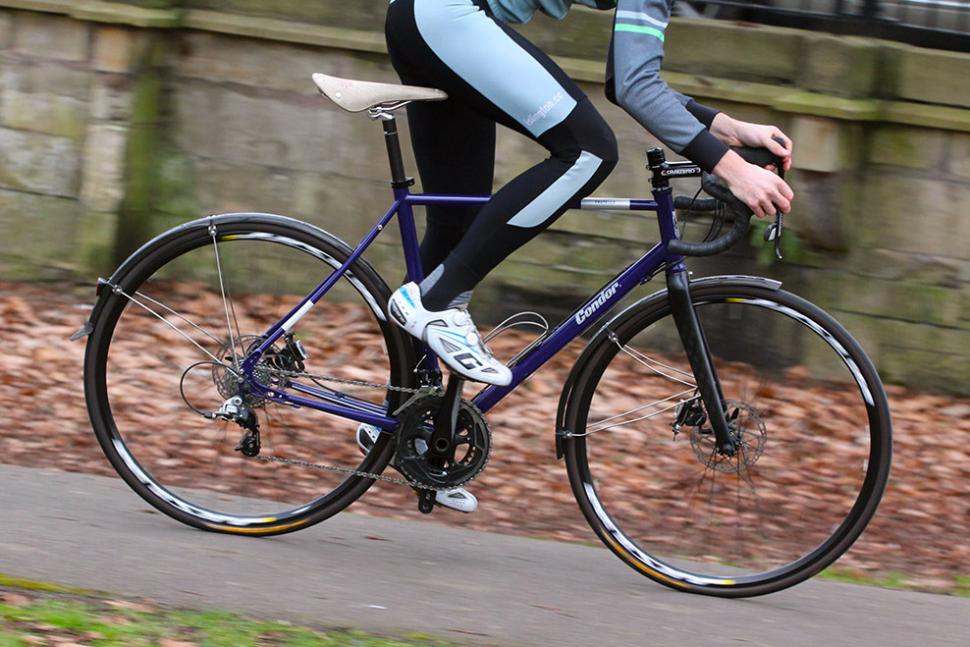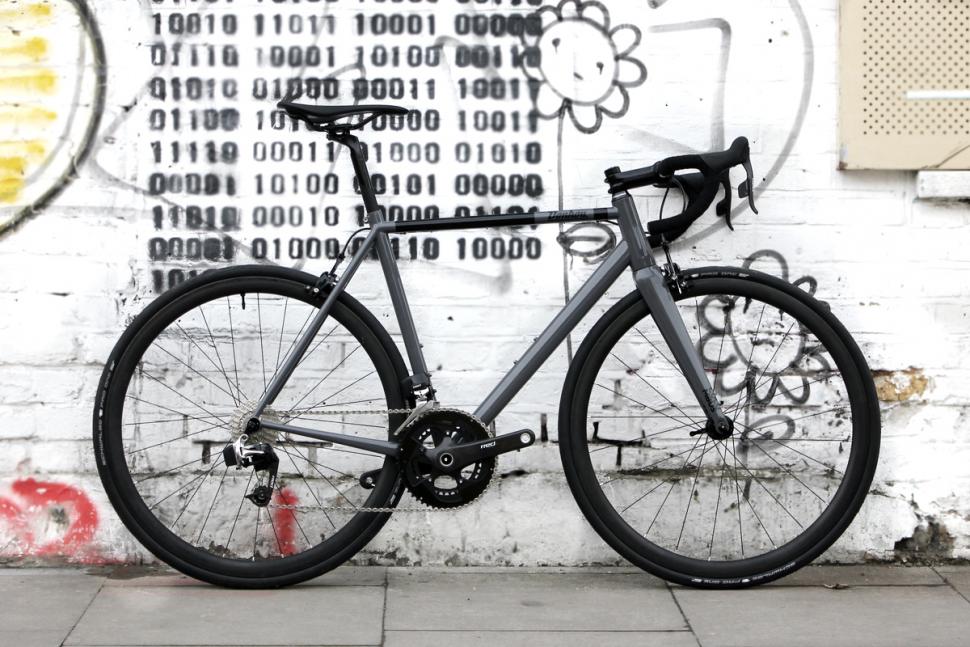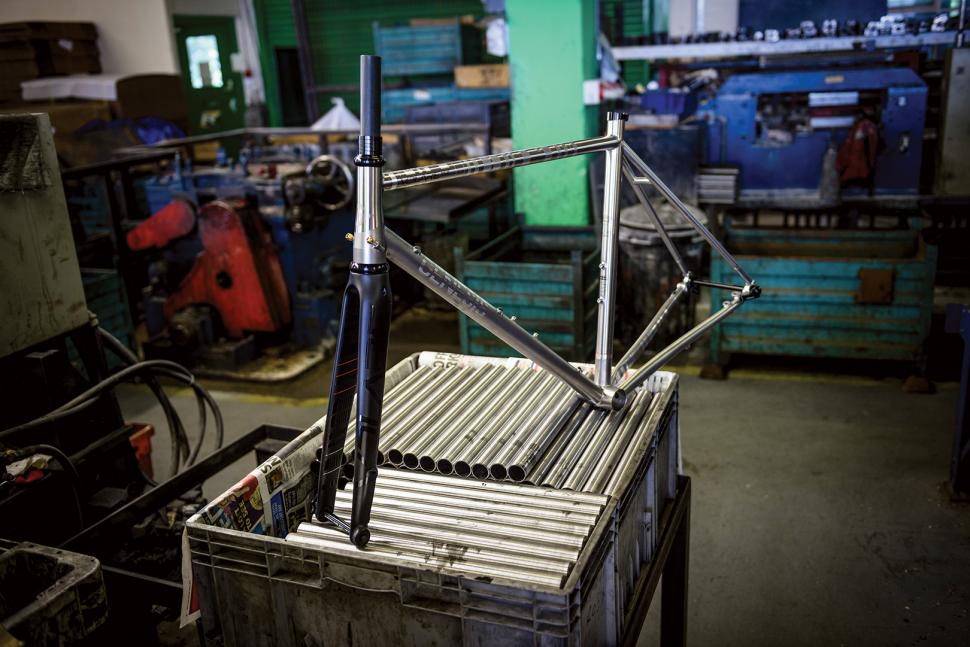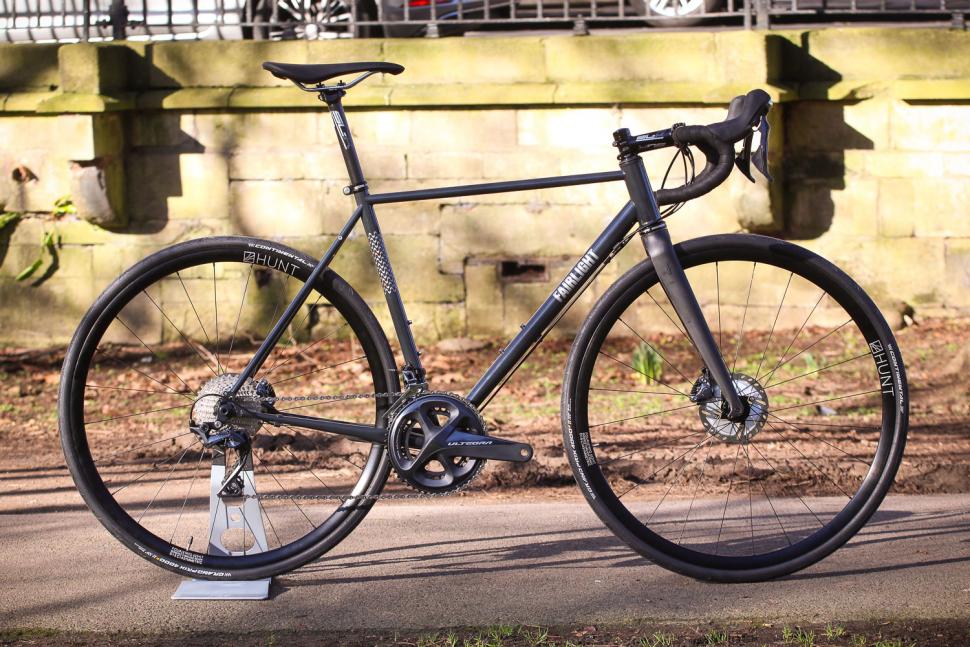- News
- Reviews
- Bikes
- Accessories
- Accessories - misc
- Computer mounts
- Bags
- Bar ends
- Bike bags & cases
- Bottle cages
- Bottles
- Cameras
- Car racks
- Child seats
- Computers
- Glasses
- GPS units
- Helmets
- Lights - front
- Lights - rear
- Lights - sets
- Locks
- Mirrors
- Mudguards
- Racks
- Pumps & CO2 inflators
- Puncture kits
- Reflectives
- Smart watches
- Stands and racks
- Trailers
- Clothing
- Components
- Bar tape & grips
- Bottom brackets
- Brake & gear cables
- Brake & STI levers
- Brake pads & spares
- Brakes
- Cassettes & freewheels
- Chains
- Chainsets & chainrings
- Derailleurs - front
- Derailleurs - rear
- Forks
- Gear levers & shifters
- Groupsets
- Handlebars & extensions
- Headsets
- Hubs
- Inner tubes
- Pedals
- Quick releases & skewers
- Saddles
- Seatposts
- Stems
- Wheels
- Tyres
- Health, fitness and nutrition
- Tools and workshop
- Miscellaneous
- Tubeless valves
- Buyers Guides
- Features
- Forum
- Recommends
- Podcast
 Condor Fratello - riding 1
Condor Fratello - riding 1Steel appeal: find out why bike makers and riders still love steel bikes
Once upon a time, all bicycles were made from steel, from shopping bikes to Tour de France-conquering race bikes. Rapid technological developments over the past few decades have seen lighter materials like aluminium, titanium and, most recently, carbon fibre push steel out of the spotlight.
Is steel dead, though? Far from it. If anything, it is enjoying a resurgence of interest. Although racing cyclists no longer favour steel, it continues to be the desired frame material for anyone wanting a bike for comfort, distance and durability. That’s why touring and audax bikes tend to be steel, not carbon fibre.
Despite impressive material advances over the years, steel has refused to disappear into the history books. Material and tube developments from the two main steel tubing suppliers, Columbus and Reynolds, and interest from cyclists looking for something a little different, have fuelled a growth in the number of frame builders, meaning there's now a lot more choice if you want a steel frame for your next bike.
Going bespoke
There has been a surge of new frame builders joining more established names over the past few years, all catering to the increasing number of cyclists wanting to go down the custom frame route. And custom frame building is far easier with steel than carbon and aluminium.
- Great custom handbuilt frames — from makers who can craft your dream frame
Jim Walker, the founder of titanium and steel specialist Enigma, puts this renewed popularity down to steel being easy to work with and allowing creative freedoms to be indulged. Though he also suggests it's the attraction of the fabled ride quality of a high-quality steel frame that is drawing in new customers.
“It’s always been a great material for frame builders as it’s relatively easy to work with," he says, "plus it’s great for customisation. Steel allows a craftsman to be creative and to create something beautiful."
There's also the reputation steel has for a springy and indulgent ride character, something Walker feels is also a factor in why more people are choosing it over other materials. “It’s hard to say why steel has seen such a renaissance in recent years, but maybe it’s just that it offers a riding experience that differs from everything else.
"Steel somehow feels more alive than other materials and makes for a wonderful ‘zingy’ ride quality," says Walker. "It’s hard to articulate the ride quality of a well designed and built steel bicycle.”
“It’s the aesthetics and ride quality that makes many choose steel,” agrees Tom Donhou of Donhou Bicycles, one of the new generation of frame builders.
While a key attraction of steel for these newer frame builders is that it’s easy, and relatively affordable, to work with, for the customer it means a fully bespoke custom frame, from geometry to paint finish, right down to every little last detail. That is rarely possible from mainstream manufacturers working in other materials.
It's also the relationship with the person building their frame that makes going down the custom route appealing for many, and that's more likely to be steel than any other material. The frame is likely to be made in the UK, and probably not far from where the customer lives. It used to be the case that racing cyclists would go to their local frame builder, when most towns could boast a frame builder, to be fully measured up for a steel racing bike.
Steel bikes back in the professional peloton
Up until the 1980s, most of the professional peloton raced on steel bicycles, before new materials promising lighter weight and increased stiffness made them obsolete. But even in racing steel has enjoyed a resurgence. For a couple of years the Madison-Genesis team put steel bicycles back in the professional peloton with the highly regarded Volare race bike.
“The main driving force [behind the Madison-Genesis team] was essentially to prove that steel, albeit in this ‘super steel’ form, is still a competitive material to build bikes from,” Genesis brand manager Albert Steward told us at the time.
“With the fairly recent developments of the new ‘super steels’ (Reynolds 953 and Columbus XCr), the feeling from inside the product team was that it might be a good time to revisit steel in a race context and see what we could do," he added.
The team and its Volare bikes made a significant mark, though Madison-Genesis has since switched to the Zero SL carbon fibre platform. The siren song of carbon is hard to resist.
Steel goes oversize
Conventional wisdom regarding steel is that the inherent ‘springiness’, which provides superb ride comfort, is largely due to the small diameter tubes commonly used. Steel is also durable and very strong and, provided it’s properly treated, there’s no reason why rust should be a problem. But it’s the latest advancements by Reynolds and Columbus that have opened up new opportunities for frame builders.
- 18 of the best steel road bikes and frames — great rides from cycling's traditional material
“Working with steel, you’re pretty much confined to tube shaping if you’re wanting to increase stiffness without increasing weight, the obvious quick stiffness fixes being increasing tube diameter or wall thickness,” said Steward, adding that the latest steel tubesets, according to feedback from the race team, were actually too stiff.
“With the Volare version five we’ve actually downsized the top tube, working closely with Reynolds on a new sunk-down, fully oval custom tube with a view of dropping weight and increasing in-saddle comfort,” he said. “They’ll also run a new drawn tapered head tube which is lighter than the previously used straight Ø44mm model, so, yep, there are absolutely still improvements to be made.”
The latest steel tubesets have pushed up the diameter of tubes, and long gone are the days of skinny tubed performance steel road bikes.
This visual appearance is another factor in their appeal, reckons Jim Walker.
“The new lightweight steels - and I don’t include stainless steel here - have certainly brought the weight of high-end steel frames down to a more competitive level, but that’s only part of the appeal,” he says. “They have also given steel frames a more contemporary look which appeals to many. Not everyone likes the look of skinny frame tubes.”
Despite materials like aluminium, titanium and carbon fibre superseding steel on most fronts, steel has refused to slip into the shadows and is still a very good choice for building a bicycle frame.
“I think people are now realising that carbon isn't always the best material for their type/style of riding. A carbon race bike isn't the best bike for all applications and people are now realising this,” says Tom Donhou.
“Carbon is an amazing material, and if ultimate weight saving is what you are after then there really is no match. However, chasing numbers don't always add up to the most enjoyable ride. The steels we now use are truly modern materials and for the riders in the know, to sacrifice a few grams for more comfort and the feel of steel, there really is no competition.”
There's another consideration many cyclists are factoring in when buying a new bike. A carbon frame can look dated pretty quickly, as larger bike brands change models and paint jobs every season. That's not the case with a steel frame, which has a timeless quality to it and will still look good many years down the line. What's more, it's easy to get a steel frame resprayed, so if you get bored of the colour after a couple of years, you can easily strip it down and give it a new lick of paint.
Are steel frames expensive?
Yes and no. If you want a fully custom steel frame, it's not going to be cheap. The likes of Donhou Bicycles, Saffron, Feather, Paulus Quiros and so on have very limited resources and therefore extremely packed order books, meaning a long wait and slow turnaround time. A frame from any of these builders can start from £1,000 and rapidly rise to several times that.
It's worth remembering that you are involved in the process throughout, from the initial concept to every detail of its build, and eventual completion. You're not simply buying a frame off the shelf. It's like buying a bespoke tailored suit: you have a say in every decision.
If you aren't fussed about a custom paint job or geometry, there are cheaper options. Small UK companies like Condor, Genesis, Rourke and Enigma produce steel frames on a slightly larger scale and that means they are more affordable. Prices can start from as little as £449.99, making owning a steel frame really quite affordable. You certainly can't buy a carbon frame for that sort of money.
For all these reasons, it looks like the future for steel bicycle frames is a bright one.
- Choosing a steel, aluminium, titanium or carbon road bike
Will your next bike be made of steel?
David worked on the road.cc tech team from 2012-2020. Previously he was editor of Bikemagic.com and before that staff writer at RCUK. He's a seasoned cyclist of all disciplines, from road to mountain biking, touring to cyclo-cross, he only wishes he had time to ride them all. He's mildly competitive, though he'll never admit it, and is a frequent road racer but is too lazy to do really well. He currently resides in the Cotswolds, and you can now find him over on his own YouTube channel David Arthur - Just Ride Bikes.
Latest Comments
- chrisonabike 4 sec ago
Bristol Park Street?
- lonpfrb 11 min 7 sec ago
Nope, nothing to do with performance, everything to do with safety by keeping up in 20mph zones. Obviously doesn't help with 30mph or more, but...
- Kapelmuur 15 min 50 sec ago
I have ridden outside once this year to date. Added to the snow, ice and flood hazards has been bright, low winter sun on the few days otherwise...
- quiff 29 min 1 sec ago
From the post title I was hoping this might be a new collab.
- SimoninSpalding 55 min 26 sec ago
Whether or not I have heard of a brand is irrelevant. Before I make a purchase of a bike (or anything else that represents significant outlay/ is...
- mark1a 1 hour 8 min ago
https://lanternerouge.com/2022/12/24/the-new-world-tour-points-and-releg... https://inrng.com/2024/10/promotion-relegation-update-2024/
- hawkinspeter 1 hour 13 min ago
https://www.bristolpost.co.uk/news/bristol-news/live-bristol-road-cordoned-after-9876856...
- Jakrayan 1 hour 28 min ago
Sadly it's unlikely that trains will stop there anytime soon as it would be uneconomic to put in the facilities needed for biometrics etc as well...
- wtjs 1 hour 58 min ago
It's probably 'now' rather than 'not'
- Steve K 2 hours 17 min ago
You mean these?





Add new comment
69 comments
I own one of each too and they're all great at their slightly different jobs. I'd suggest there are too many variables to say one material is definitely better than another, for example tyre choice and pressure can have a major impact on how they feel to ride.
The last steel framed bike I had was an old Peugeot racer with downtube shifters. The frame ended up with a huge crack behind the headtube.
Poorly built mass manafacturing - as with all materials in bikes, there are some cheapies to avoid
My summer and winter bikes are both steel. The carbon fibre one is up for sale. Steel IS real.
Every cyclist should have at least one steel frame bike - so you can never forget how good they are.
Carbon Fibre frames are alright, but IMO they're generally pretty ugly. A giant, gopping headtube punctuated by a steerer tube and miniature scaffolding clamp for the stem. An integrated headset that takes hours of questioning on the internet to find a compatible replacement. A massive fat downtube leading to a similarly massive bottom bracket shell, containing some bespoke bottom bracket arrangement that will tend to creak and ruin the whole experience. Internal cabling that's a nightmare to route and which will, inevitably, rattle at some point, again spoiling the experience. Chainstays that lead to a soft aluminium hangar that will bend at the slightest sign the bike is laid down. A top tube that is so much smaller than the downtube, along with the seatstays, that the whole frame looks completely unbalanced. And a seat tube that requires a seatpost twice as long as a frame with a horizontal top tube.
And don't get me started on the logos. Huge, garish logos on every surface that benefit only the manufacturer. You become a moving advertisement - well I'm sorry, but if you want me to advertise your brand, pay me. Otherwise, keep your silly logos small and tidy.
I'll take steel. I'm not a professional athlete so I don't care if it weighs a few pounds more. I still regularly sail past my CF-framed peers on the local hills. Give me slender tubes, standardised sizes and shiny, silver components any day of the week.
You don’t like carbon frames then ?
Just my words. I ride aluminium only because it's so difficult to find steel frames (in DK). Carbon is nice but brittle and generally vulnerable to damages. I follow a couple of cycling groups on Facebook - I'm almost chocked by all the carbon riders who post damages to their carbon frames. I understand the benefits of carbon if you race for money or have a big wallet, but when you haven't got a sponsor to pay for your cracked/damaged carbon, well, some expensive miles you're riding.
Pages